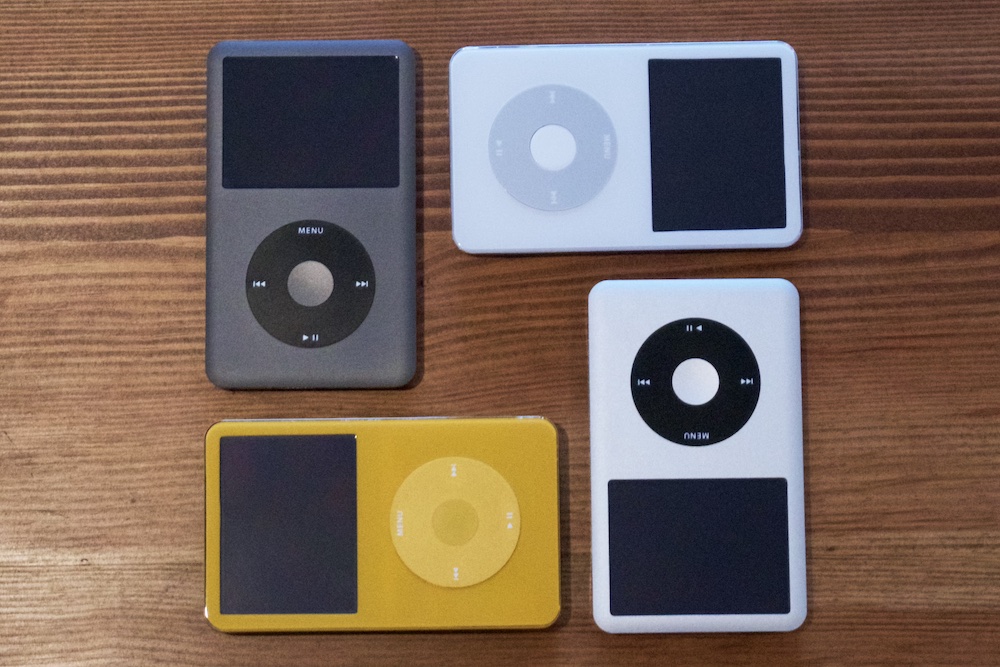I’ve found a new hobby: retro tech. Specifically, old Apple tech.
I can’t recall what started this new obsession; that is unimportant now. What matters is that I’ve now accumulated a small collection of iPods Classic, Nano, and even Hi-Fi.
I bought the first one from eBay; a refurbished model from a reputable seller. Taking it out of its box, plugging it in and listening to its tiny hard disk whir into life filled me with nostalgia for a bygone era.
Shortly thereafter, I found tens of thousands of other people, rocking their iPods on r/iPod. Many of them were modding them with parts they bought online; new face plates in never-available colours, and SSDs to replace the aging hard-drives.
It got me thinking: could you roll your own iPod… from spare parts?
The answer is “yes”.
There aren’t many pieces to find
Building your own iPod Classic requires sourcing only a dozen or so parts, some of which you can get as a bundle. I used AliExpress to get most them, but there are plenty of eBay sellers for these parts too1. You need:
- a logic board
- a display
- a battery
- the housing – consisting of a front panel and a click wheel, and the rear panel and its plastic 30-pin connector surround
- a hard drive, solid-state drive or SD card module
- the interior metal framework
- a headphone jack and hold switch
- a set of screws
The most expensive component is the logic board. Where all the other components seem to be fresh off a production line, the logic boards aren’t. They’re usually recovered from old, thrown away models and so are in increasingly rare supply.
In all, the parts cost around £100 to £150 depending on the generation of iPod you want, plus cost of the storage.
It doesn’t take long to build
Once you have all the parts, it’s actually incredibly simple to put together. I did it in about 30 minutes2, following pieces of tutorials from iFixit.
After I’d reconstituted my kit-bashed iPod, I plugged it into my Mac and I was off to the races. An hour later and I was able to plug in some authentic Apple EarPods and start listening to my tunes.
How many iPods is too many iPods?
Of course, having found building one iPod so easy3, I went off to build several. Four iPods Classic now adorn my office shelves. Aside from the 7th generation model I bought pre-made, I’ve now constructed:
- a 5th generation ‘thin’ model in white with an iFlash Solo SD card for storage
- a 7th generation ‘thin’ model in a MacBook style – a matt silver front-plate with black click wheel – and an SSD
- a 5th generation ‘thick’ model in yellow and black that I’ve affectionately named ‘BananaPod’, and an SSD

iPod Classic (7th gen). Black. 80GB HDD.
iPod Classic (5th gen). White. 60GB MicroSD.
iPod Classic (7th gen). Silver. 120GB SSD.
iPod Classic (5th gen). Banana. 80GB SSD.
Each of these models works as if they were brand new from the Apple Store, and they’re in hues and with functionality that was never available when they first went on sale.
A touch of nostalgia never hurt anyone
It might seem quaint to be reaching back to the early 2000s and building these rudimentary music players. It probably is. But now I have my entire music collection on 4 little devices that I can take with me anywhere, that doesn’t cost me a monthly subscription fee, and that I can use without an internet connection.
If like me, you’ve got a gadgety itch to scratch, this is a fairly inexpensive way to spend a few hours on the weekend, and you’ll have a beautiful device to own at the end.
Footnotes
I tend to find that many of the modules and parts you can get on eBay are available for substantially less on AliExpress. My hunch is that UK-based eBay sellers buy job lots from AliExpress and then just sell them on locally. AliExpress isn’t great – I’ve found the deliveries to be unreliable, and the customer service is abysmal if things go wrong – but if you can wait a little for the delivery, it can save you a lot of money. ↩︎
It took longer to restore the software on the device and to sync the dozens of gigabytes of music I had on my Mac, than it did to put the thing together! ↩︎
Or at least, easy if you want to build a 5th, 6th or 7th generation iPod Classic. Other iPods are harder because of parts availability and because most other, non-Classic iPod models use soldered parts that you can’t replace. ↩︎
